The Literary Flair of S.W.R.D. Bandaranaike
Posted on December 10th, 2015
By Bhagavadas Srikanthadas
Before I am their equal”, I must become their superior”.
This daring contradiction was S.W.R.D. Bandaranaike’s well thought out recipe for gaining entry into the inner portals of Oxford.
An Englishman is generous in recognising merit in others; it is more difficult to overcome the various barriers to his friendship. Once, however, his respect is obtained, it is easy to become his friend. And what a true and loyal friend he can be!” exclaimed the man who found the golden key to English friendship”. D.B.Dhanapala
S.W.R.D. Bandaranaike, known to many as a politician, was born on January 8, 1899 and succumbed to an assassin’s bullet on September 26, 1959. It’s unfortunate no serious study has been ever done to evaluate his life from a literary perspective.
To find out about Bandaranaike’s literary skills, his Speeches and writings” remains a treasure trove. This volume was published by the Department of Broadcasting and Information, to coincide with the fourth death anniversary of the late Prime Minister’s death. Bandaranaike’s Memories of Oxford” which appears in this volume is a collection of articles he wrote to a Colombo journal The Ceylon Causerie less than a decade after he left Oxford. This series of articles written in an elegant style, though at times may appear to be in stilted form, encapsulates his days at this prestigious institution. These writings help the reader to get a better understanding not only of the challenges that under-graduates from the colonies faced at Oxford, but also about the writer’s interest in the field he opted to study as well as some interesting information about a few of his contemporaries who were destined to enter the world of the literati.
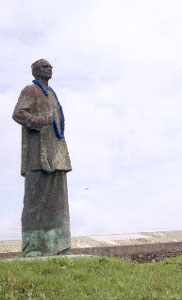 S.W.R.D. Bandaranaike statue at Galle Face Green, Colombo
S.W.R.D. Bandaranaike statue at Galle Face Green, Colombo
Western classics
Bandaranaike owes a great deal to A.C. Radford for introducing him to western classics at an early age. It was Sir Solomon, father of young Bandaranaike, who engaged Radford of Cambridge University as full time private tutor to his son. The scholar from Cambridge not only introduced his protégé to Chaucer and Milton but also provided a thorough grounding in classics. As tutor he was provided accommodation at the ancestral residence of Bandaranaike’s at Horagolla, where he remained for four years till his protégé turned fifteen.
Later Bandaranaike was admitted to S Thomas’ College, Colombo as a boarder during the warden-ship of Stone. The tutoring he had from Radford provided young Bandaranaike with an edge over his classmates. Not surprisingly, a few years later when he sat for the Cambridge Senior he performed exceptionally well, obtaining distinctions in English and Latin.
Bandaranaike read classics at Oxford during a period where it was unusual for anyone other than an English public-schoolboy to read for Litterae Humaniores”. As an undergraduate at Oxford he was fascinated by Prof. Gilbert Murray’s lectures on Homer and Prof. Garrod’s on Virgil.
Oxford contemporaries
Amongst his Oxford contemporaries, there were a few who were destined to excel as writers of great repute. The friendship Bandaranaike forged with Edward Marjoribanks lasted till the early death of the latter. After leaving Oxford, Marjoribanks made great strides as a politician, lawyer and also an author. There are several books to his credit and The Life of Marshall Hall”, the biography of a great criminal lawyer, is considered to be his magnum opus.
In his Memories of Oxford” Bandaranaike also alludes to Evelyn Waugh, an undergraduate four years younger than him. Evelyn wrote several novels including Decline and Fall, A Handful of Dust, etc. At Oxford when Bandaranaike was functioning as Junior Treasurer, prior to being elected as Secretary of the Union, had an ‘encounter’ with Waugh over collecting subscription which was in arrears.
Leelamani Naidu, daughter of Sarojini Naidu, attended Oxford during Bandaranaike’s days. According to him She possessed all the charm of her mother, and gave promise of developing much of her talent”.
The short story as a genre always fascinated Bandaranaike. In Memories of Oxford” he recalls a short story he wrote for the Cardinal’s Hat, his College magazine, which was returned”. This didn’t dampen his desire to try his hand as a short story writer on his return to Ceylon.
Loathing for respectable garment
After being away from home for six years, Bandaranaike returned in early 1925. To keep his literary interests alive in Ceylon, he co-edited The Island Review with J. Vijayatunga. In the September 1926 issue of this journal Bandaranaike’s short story The Kandy Perahera” appeared. This story serves as a prism for readers to view the conflict taking place within the writer and how it spilled over as a symbolic manifestation of loathing for ‘his stiff shirt front and collar’ considered by the West as the respectable garment of civilisation.
The Mystery of the Missing Candidate, a story serialised in the Sunday Times of Ceylon during the early part of 1951, gives a glimpse of the life a candidate has to put up with during a Sri Lankan election. This story is leavened with a touch of humour. By the time this story was written Bandaranaike had turned out to be a seasoned hustings performer, and was aware of the ways everyone paid blatant disregard to the edicts from the Election Office. Probably the writer sees in his hero, Sunil Rajapakse, a mirror image of himself! The hero lives in an ancestral house built during the Dutch period by his grandfather. Sunil Rajapakse on return from Oxford University on completion of his studies, takes to politics like the writer.
The story portrays how the candidate virtually becomes a prisoner in the hands of his supporters, dancing to their tune by participating in processions and propaganda meetings; the ancestral home turned into a twenty-four hour kitchen to feed all and sundry who masqueraded as well wishers. Bandaranaike through this story explains how politics can change an honourable person to trim his sails to every wind and make him lead a Jekyll and Hyde” life. Finally, Sunil Rajapakse, a person with an intellectual leaning, finds an escape route that would give him much needed tranquility.
Bandaranaike who enjoyed reading classics found equal pleasure with horror stories and detective novels. Edgar Alan Poe, Agatha Christie and Sherlock Homes are some of the writers to whom he alludes in his writings. In most of his short stories including The Horror of Mahahena, we come across a fictional character John Ratsinghe who helps us un-tangle mind boggling mysteries. Bandaranaike sees in John Ratsinghe the local counterpart of Sherlock Holmes – a truth he makes more obvious in The adventures of the Soulless Man.
Bandaranaike’s writings show he had enormous creative skills which if developed could have taken him to great literary heights. Probably he would have been another Evelyn Waugh!
Courtesy: The Nation
Sir Soloman Dias Bandaranaike with wife & SWRD as a baby
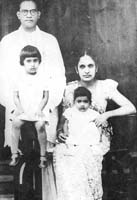
The Bandaranaike-Ratwatte wedding
“I attended the wedding of ‘Young Banda’ to Miss Ratwatte (daughter of Disawa Barnes Ratwatte and niece of the late Sir Cudah) at Balangoda and a week later, their ceremonial homecoming to Sir Solomon Bandaranaike’s residence near Veyangoda. This marriage is of great sociological and political importance. Whatever opinion one may hold of young Bandaranaike as Minister for Local Administration, or as founder and leader of the Sinhala Maha Sabha or as a pervert for political purposes from Christianity to Buddhism or as a master of nationalist rhetoric, one is bound to admit that he has taken to himself a wife who appears thoroughly nice, placid and sensible and that this union between a first-rank family of the lowlands with a first-rank family of the Kandyan highlands represents an accretion of considerable political influence to the Sinhala Maha Sabha.”
An Extract from ‘Things Ceylonese’: twelfth periodical report by Sir Andrew Caldecott for CO (Colonial Office) from British Documents on the End of Empire edited by K.M de Silva.
Death of S.W.R.D. Bandaranaike (1959)
Mrs. Sirima Bandranaike paying her last respects to her dead husband lying in state at their residence at Rosmead Place
From left to right R.G. Senanayake (Minister of Trade and Commerce), Lionel Fernando (Director of Information), Mrs. Sirima Bandaranaike, young Anura Bandaranaike (in national dress)
Mrs. Sirima Bandaranaike with Chairman Mao Tse Tung in Beijing (1972)
Mrs. Sirima Bandaranaike welcoming Col. Muammar Gadaffi of Libya to the 5th Summit of the Non – Aligned Conference held in Colombo in 1976
Mrs. Sirima Bandaranaike with Saddham Hussein in Colombo (1975)
Mrs. Sirima Bandaranaike with Mrs. Indira Gandhi (1976)
See also
The Assassination of S.W.R.D. Bandaranaike An Anecdotal Reflection
Note: 5 Comments in Lankaweb
http://www.island.lk/index.php?page_cat=article-details&page=article-details&code_title=132461
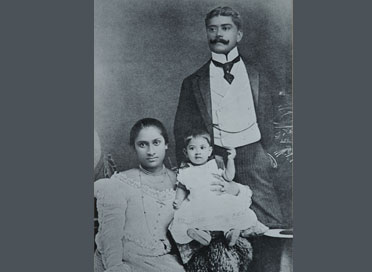
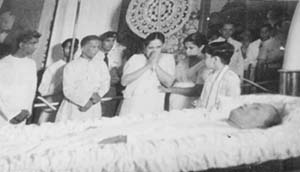
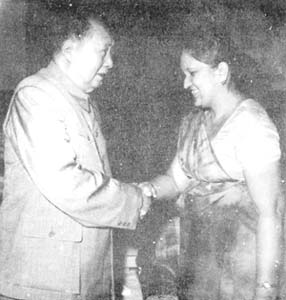
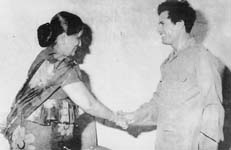
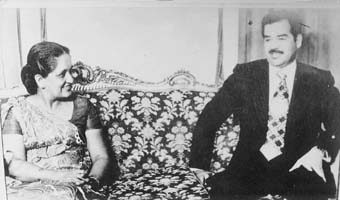
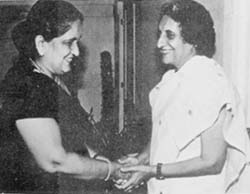
December 11th, 2015 at 6:46 pm
Bhagavadas Srikanthadas, Please tell us who are You and whom pays you kappan to publish on Lanka web? Are you correct of the date of the assignation?
December 11th, 2015 at 6:56 pm
These history lessens by Senaka Weeratne is about getting the focus out of Current SL situation. OOPS you forgot to state about the house your father was building next to SWARD’s house in Rosemead Place. Go back and put an amendment.